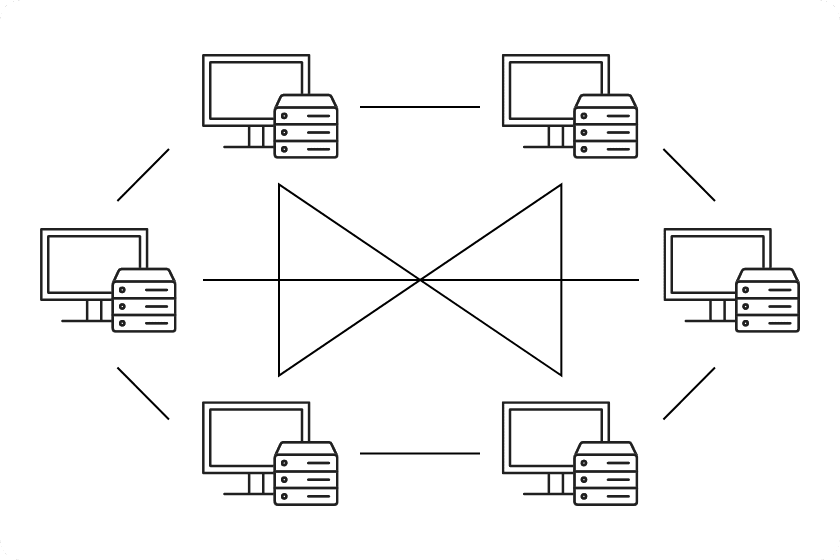NonEntropy's IPFS data center
NonEntropy's
IPFS data center
One of the biggest decentralized network data center in Japan
IPFS(InterPlanetary File System) is a distributed hyper media protocol, contents address, and P2P.
The current mainstream protocol on the internet is HTTP, which our sites runs on it. This site also uses the HTTP protocol to deliver and retrieve content.
In this HTTP, content is delivered and retrieved by specifying a specific URL, and the URL indicates the location (address) where the content is stored.
Therefore, HTTP will display an error if the server where the content is stored cannot be accessed for some reason.
IPFS, on the other hand, specifies a unique address (CID) that exists for each file, not an address.If the file is identical, the same CID is generated.
If you specify the CID with an IPFS-compatible browser, you can retrieve the content regardless of where the server is located.

IPFS as an alternative to HTTP
In IPFS, individual servers are interconnected, allowing users to retrieve content from any server as long as the file is stored on the node.
Nodes are individual computers connected to the IPFS network, and these nodes are analogous to the myriad of planets, hence it is given the name "Interplanetary File System," or IPFS.Decentralization is an advantage of IPFS.The HTTP protocol cannot retrieve content if the server is unavailable for some reason, as mentioned earlier. IPFS, however, allows users to retrieve the content as long as at least one of the myriad computers with the content is online.
IPFS also makes content censorship difficult: in HTTP, content censorship is possible if the server and URL can be identified, but in a decentralized network with IPFS, it is impossible to identify where files are located, and therefore content blocking is not feasible.
Another advantage is the high speed content retrieval. For example, if a server is located in the U.S. and you try to access it from Japan, the communication distance would be thousands of kilometers. However, through the IPFS protocol, users can retrieve content from a nearby node, and in extreme cases, retrieving content from a server in a neighboring house can increase the speed of content retrieval because the communication distance is only a few meters.
Additionally, IPFS generates a CID based on the content, as mentioned earlier.In short, on the IPFS network, the same content will have the identical CID, and if the content changes even slightly, the CID will change as well. IPFS therefore has the advantage of preventing tampering compared with HTTP.

- Decentralized storage
- Decentralized load balancing
- Fault tolerance
- Censorship-resistant
- High security
- Tamper-resistant
Storage Mechanisms
In general blockchain, a "network provider" is a participant on the network that performs the tasks necessary to generate a new blocks.In return for their work, network providers get cryptocurrency. For example, in bitcoin, network providers (miners) can generate blocks by performing a large number of hash calculations and get bitcoin in return.
Filecoin's network provider does not provide computing power like bitcoin does. Instead, storage capacity is offered to users who wish to store data.
Types of Storage Providers
There are several types of Filecoin storage providers. This section covers the main storage providers: storage providers and retrieval providers.
Storage providers earn Filecoin by storing client data and proving that the data has been stored in their storage for a certain period of time. The probability of earning block rewards and transaction fees is proportional to the amount of storage the provider has provided on the Filecoin network, not the amount of hashes computed.
Retrieve providers are participants who conduct file retrieval transactions with clients. They earn Filecoin by delivering specific files to clients from the network. Compensation is determined by the market value of the file size.The retrieve provider's bandwidth and transaction bid/initial response time (latency and proximity to clients) determine its overall capacity to fulfill retrieval transactions on the network. The maximum bandwidth of a retrieve provider is the total amount of transactions it can perform.
Deals
The Filecoin network allows storage providers and clients (storage users) to make "transactions" in which they contract for storage and retrieval at a price agreed upon.
Clients may select a storage provider to store their data, subject to available capacity, duration, and price. They then pay sufficient funds to the relevant wallet to cover the total cost of the transaction, and once the storage provider agrees to the storage contract, the transaction is to be published.
After the transaction is published, the client prepares the data for storage and transfers it to the storage provider. Upon receipt of all data, the storage provider packs and seals the data into sectors and begins submitting proofs to the blockchain. Once the initial confirmation is submitted, the client can verify that the data has been properly stored and the transaction is officially initiated.
During the life of the transaction, the storage provider must continuously submit proof to the blockchain that the data has been stored correctly. Clients make payments in phases using previously locked funds. The storage provider will be penalized if proof of file storage is missing or delayed.
-

About
 LEARN MORE
LEARN MORE
-

Hubs / Networks
 LEARN MORE
LEARN MORE
-

Services
 LEARN MORE
LEARN MORE
-

System Development
 LEARN MORE
LEARN MORE
